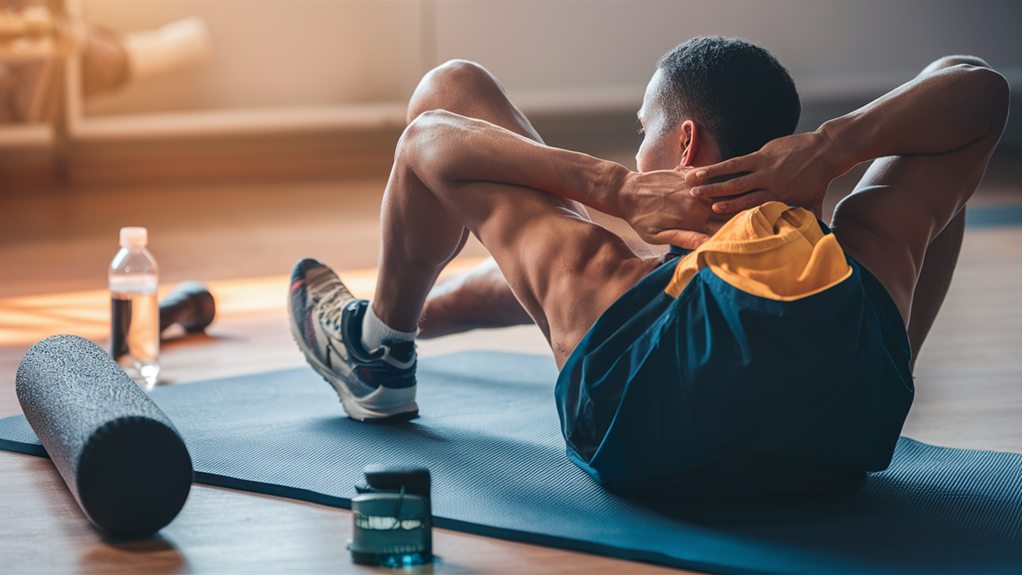HIIT (High-Intensity Interval Training) maximizes your workout efficiency by alternating between intense exercise bursts and brief recovery periods. You'll push yourself to 80-95% of your maximum heart rate during short, challenging intervals lasting 20-60 seconds, followed by rest periods. This powerful training method triggers an "afterburn effect," helping you burn calories even hours after exercising. HIIT improves your cardiovascular health, builds strength, and enhances insulin sensitivity while saving valuable time compared to traditional workouts. Whether you choose running, cycling, or bodyweight exercises, HIIT offers versatile options for achieving your fitness goals. Understanding proper form and safety guidelines will help you access HIIT's full potential.
What Is HIIT

With its growing popularity in fitness circles, High-Intensity Interval Training (HIIT) alternates between short bursts of intense exercise and brief recovery periods. During these workouts, you'll push yourself to your maximum effort for short durations, typically ranging from 20 to 60 seconds, followed by periods of lower-intensity movement or complete rest.
Incorporating HIIT into your routine can greatly boost your cardiovascular health and overall fitness, as it enhances heart function and increases endurance, which are key benefits of cardiovascular exercise boost your health.
The beauty of interval training lies in its versatility and efficiency. You can perform HIIT using various exercises, from running and cycling to bodyweight movements like burpees and mountain climbers.
During the high-intensity portions, you'll work at 80-95% of your maximum heart rate, while recovery periods allow your heart rate to decrease before the next intense interval begins.
What makes HIIT unique is its ability to produce considerable fitness gains in less time than traditional steady-state cardio. When you perform these intense intervals, your body continues to burn calories even after you've finished exercising, thanks to what's called the "afterburn effect."
This makes HIIT an excellent choice if you're looking to improve your cardiovascular fitness, build endurance, and maximize your workout time.
Benefits For Your Body
HIIT's impact on your body extends far beyond just burning calories. When you perform these intense workouts, you'll trigger a powerful "afterburn effect," where your body continues to burn calories for hours after you've finished exercising. This metabolic boost helps maximize your fat loss while preserving lean muscle mass, making it more effective than traditional steady-state cardio.
Additionally, HIIT workouts can save time without compromising results, allowing you to get the most out of your exercise routine.
Your cardiovascular system gets a significant upgrade through HIIT training, as your heart learns to pump blood more efficiently. You'll notice improvements in your endurance, and your body will become better at using oxygen during both exercise and rest.
The quick bursts of intense activity followed by brief recovery periods help strengthen your heart muscle and improve your overall stamina.
HIIT also enhances your body's insulin sensitivity, which means you'll process carbohydrates more effectively. This improvement helps regulate blood sugar levels and supports healthy weight management.
Additionally, you'll build stronger bones, increase your muscle strength, and boost your power output, all while spending less time exercising compared to traditional workout methods.
Getting Started With HIIT

Beginning with HIIT requires a thoughtful approach to avoid injury and maximize results. Before diving into intense workouts, you'll want to assess your current fitness level and consult with your doctor, especially if you have any health concerns or previous injuries.
Start by mastering basic exercises like squats, lunges, and push-ups with proper form before adding the intensity that HIIT demands. Exploring different types of HIIT workouts, such as circuit training, can also help you find the right fit for your fitness journey.
When you're ready to begin, choose a simple workout structure that includes short bursts of exercise followed by brief rest periods. You might start with a basic pattern of 30 seconds of work and 30 seconds of rest, repeating this cycle for 10-15 minutes. As you build stamina, you can gradually increase the work intervals and decrease the rest periods.
Select exercises that target different muscle groups, such as mountain climbers, burpees, and jumping jacks. Begin with just two HIIT sessions per week, allowing your body plenty of time to recover between workouts.
Remember to warm up properly before each session and cool down afterward, focusing on proper breathing techniques throughout your workout to maintain control and prevent exhaustion.
Sample HIIT Workout Routines
A well-structured HIIT workout combines strategic exercise sequences with precise timing to maximize your calorie burn and muscle engagement. For those looking to tailor their HIIT workouts, it's crucial to reflect on your fitness level and personal goals.
You'll want to start with a basic template that includes 30 seconds of intense exercise followed by 15 seconds of rest, repeating this pattern for 15-20 minutes.
For beginners, try this simple HIIT workout: Start with jumping jacks, followed by push-ups, then high knees, and finally mountain climbers. Complete each exercise at maximum effort for 30 seconds, rest for 15 seconds, then move to the next exercise. Repeat this circuit 3-4 times.
Advanced exercisers can try this challenging routine: Begin with burpees, shift to squat jumps, move to plank-to-stands, and finish with sprinting in place. Maintain the same 30:15 work-to-rest ratio, but increase the intensity of each movement. For maximum results, you'll want to perform 5-6 rounds of this circuit.
Remember to modify these HIIT workouts based on your fitness level, and always maintain proper form even when fatigue sets in. Keep a water bottle nearby, as these intense sessions will definitely make you sweat.
For more tailored suggestions, check out HIIT recommendations for different fitness levels.
Recovery and Safety Tips

While performing these intense HIIT workouts can deliver impressive results, proper recovery and safety measures will determine your long-term success. Your body needs adequate time between sessions to repair muscle tissue and restore energy systems involved in metabolic conditioning.
Make sure you're getting 48-72 hours of rest between HIIT workouts, and don't schedule more than 2-3 sessions per week. Incorporating essential injury prevention tips is vital for maintaining your overall health and performance.
Before each workout, spend at least 10 minutes warming up with light cardio and dynamic stretches to prevent injury. Listen to your body, and if you're feeling unusually fatigued or experiencing persistent muscle soreness, take an extra rest day. Stay hydrated by drinking water before, during, and after your sessions, and maintain proper form throughout each exercise.
To support recovery, focus on getting 7-9 hours of sleep each night, and eat a balanced diet rich in protein and complex carbohydrates.
If you're new to HIIT, start with shorter intervals and gradually increase intensity as your fitness improves. Remember to modify exercises when needed, and don't hesitate to take breaks if you're struggling to maintain proper form.



